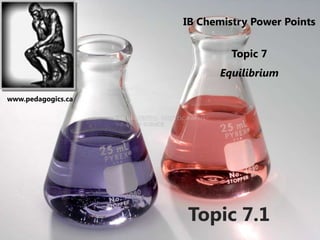2012 topic 7.1
•Transferir como PPTX, PDF•
1 gostou•1,645 visualizações
Denunciar
Compartilhar
Denunciar
Compartilhar

Recomendados
Mais conteúdo relacionado
Mais procurados
Mais procurados (20)
Tang 10 substitution & elimination reactions 2

Tang 10 substitution & elimination reactions 2
Destaque
Destaque (20)
Ppt djy 2011 topic 5.1 electric potential difference sl

Ppt djy 2011 topic 5.1 electric potential difference sl
IB Astrophysics - intro to the universe - Flippingphysics by nothingnerdy

IB Astrophysics - intro to the universe - Flippingphysics by nothingnerdy
Semelhante a 2012 topic 7.1
Semelhante a 2012 topic 7.1 (20)
Core & Extension - Chemical Rxns - Reversible Rxns I.pptx

Core & Extension - Chemical Rxns - Reversible Rxns I.pptx
1st Lecture on Chemical Equilibrium | Chemistry Part II | 11th Std

1st Lecture on Chemical Equilibrium | Chemistry Part II | 11th Std
New chm-152-unit-2-power-points-sp13-140227172047-phpapp01

New chm-152-unit-2-power-points-sp13-140227172047-phpapp01
Mais de David Young
Mais de David Young (20)
2011 topic 01 lecture 3 - limiting reactant and percent yield

2011 topic 01 lecture 3 - limiting reactant and percent yield
2011 topic 01 lecture 2 - empirical and molecular formulae

2011 topic 01 lecture 2 - empirical and molecular formulae
2011 topic 01 lecture 1 - the mole and avogadro's constant

2011 topic 01 lecture 1 - the mole and avogadro's constant
Último
Último (20)
Passkey Providers and Enabling Portability: FIDO Paris Seminar.pptx

Passkey Providers and Enabling Portability: FIDO Paris Seminar.pptx
Hyperautomation and AI/ML: A Strategy for Digital Transformation Success.pdf

Hyperautomation and AI/ML: A Strategy for Digital Transformation Success.pdf
New from BookNet Canada for 2024: Loan Stars - Tech Forum 2024

New from BookNet Canada for 2024: Loan Stars - Tech Forum 2024
Unleash Your Potential - Namagunga Girls Coding Club

Unleash Your Potential - Namagunga Girls Coding Club
Ensuring Technical Readiness For Copilot in Microsoft 365

Ensuring Technical Readiness For Copilot in Microsoft 365
Dev Dives: Streamline document processing with UiPath Studio Web

Dev Dives: Streamline document processing with UiPath Studio Web
How AI, OpenAI, and ChatGPT impact business and software.

How AI, OpenAI, and ChatGPT impact business and software.
Transcript: New from BookNet Canada for 2024: Loan Stars - Tech Forum 2024

Transcript: New from BookNet Canada for 2024: Loan Stars - Tech Forum 2024
Use of FIDO in the Payments and Identity Landscape: FIDO Paris Seminar.pptx

Use of FIDO in the Payments and Identity Landscape: FIDO Paris Seminar.pptx
Transcript: New from BookNet Canada for 2024: BNC CataList - Tech Forum 2024

Transcript: New from BookNet Canada for 2024: BNC CataList - Tech Forum 2024
What's New in Teams Calling, Meetings and Devices March 2024

What's New in Teams Calling, Meetings and Devices March 2024
Developer Data Modeling Mistakes: From Postgres to NoSQL

Developer Data Modeling Mistakes: From Postgres to NoSQL
DSPy a system for AI to Write Prompts and Do Fine Tuning

DSPy a system for AI to Write Prompts and Do Fine Tuning
2012 topic 7.1
- 1. IB Chemistry Power Points Topic 7 Equilibrium www.pedagogics.ca Topic 7.1
- 2. Equilibrium: “the extent of a reaction” Recall: for a chemical reaction actual yield < theoretical yield Why? Because • Reactants are not pure • Not all product is recovered • Other competing reactions use up reactant to form alternate products and some chemical reactions are reversible! Equilibrium looks at the extent (of completion) of a reversible chemical reaction.
- 3. Equilibrium: the extent of a reaction Equilibrium = no observable changes over time In chemistry we encounter two types of equilibrium systems. Physical/phase equilibrium Chemical equilibrium H2O (l) H2O (g) N2O4 (g) 2NO2 (g)
- 4. Equilibrium: the extent of a reaction Equilibrium = no observable changes over time In chemistry we encounter two types of equilibrium systems. Physical/phase equilibrium H2O (l) H2O (g)
- 5. Equilibrium: the extent of a reaction Equilibrium = no observable changes over time In chemistry we encounter two types of equilibrium systems. Physical/phase equilibrium Chemical equilibrium H2O (l) H2O (g) N2O4 (g) 2NO2 (g)
- 6. Equilibrium: the extent of a reaction A chemical equilibrium is achieved when: • the rates of the forward and reverse reactions are equal and • the concentrations of the reactants and products remain constant for example • Colorless N2O4 decomposes to brown NO2 at room temperature. The reaction is reversible. N2O4(g) 2NO2(g). • At equilibrium, there is a mixture of N2O4 and NO2. • The reaction does not stop. • The color remains constant
- 7. Key concept 1: at equilibrium, concentrations are constant
- 8. Constant concentrations imply that the forward reaction must be proceeding at the same rate as the reverse reaction. N2O4(g) 2 NO2(g) This is the forward reaction 2 NO2(g) N2O4(g). This is the reverse reaction The double arrow implies the process is reversible. N2O4(g) 2NO2(g)
- 9. Key concept 2: at equilibrium, forward rate = reverse rate N2O4(g) 2 NO2(g) 2 NO2(g) N2O4(g) “dynamic” implies that at equilibrium the reaction continues in both directions
